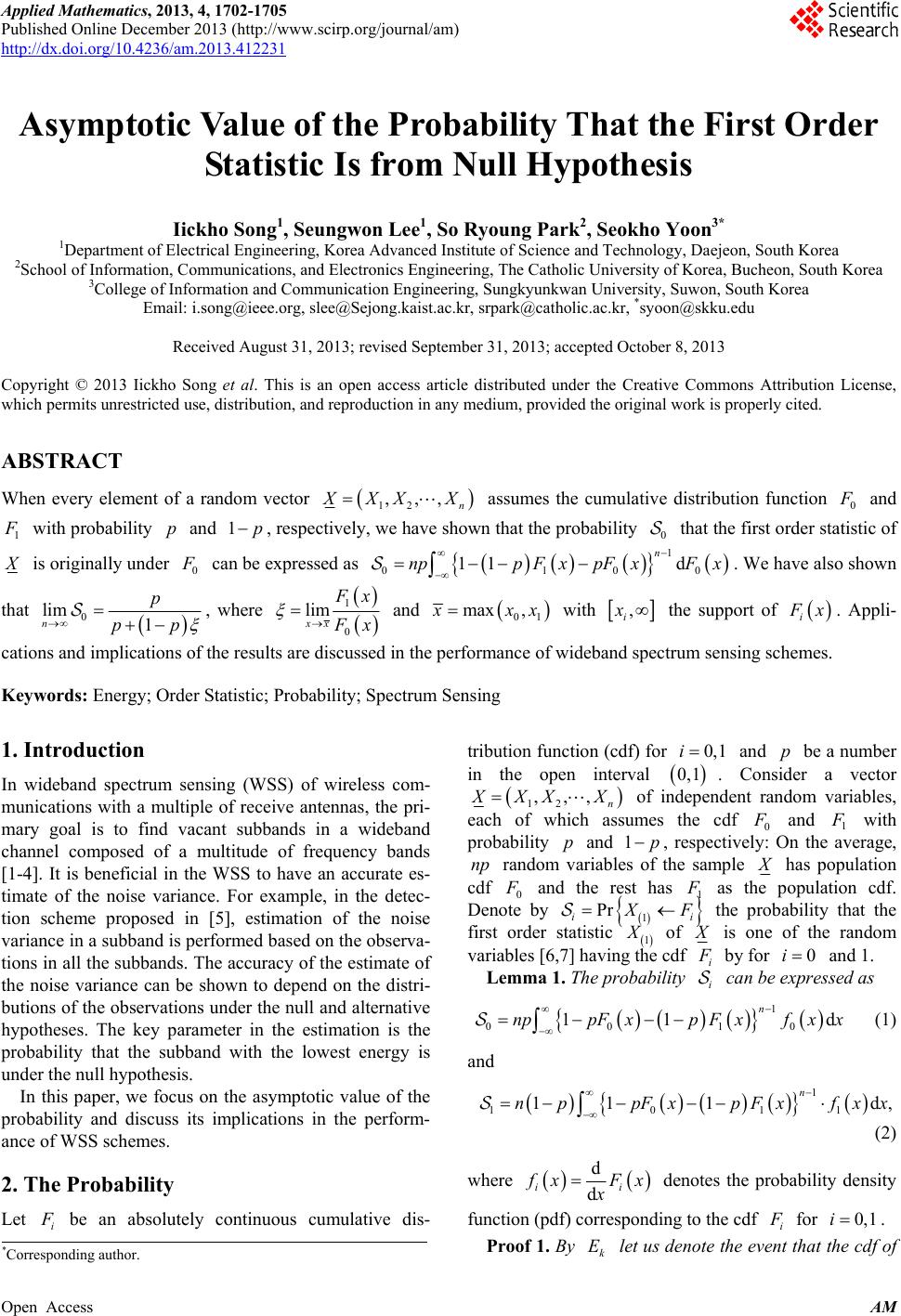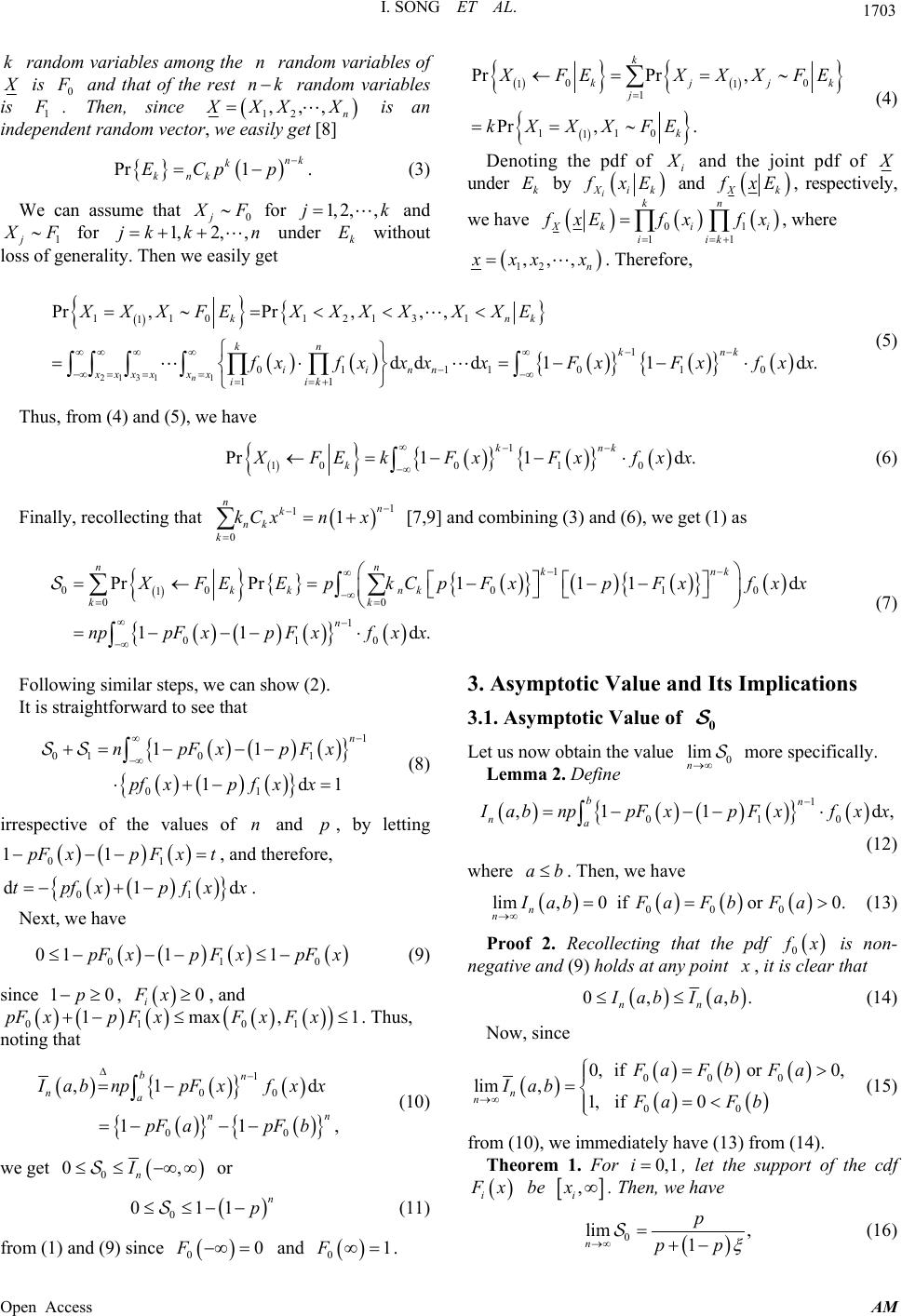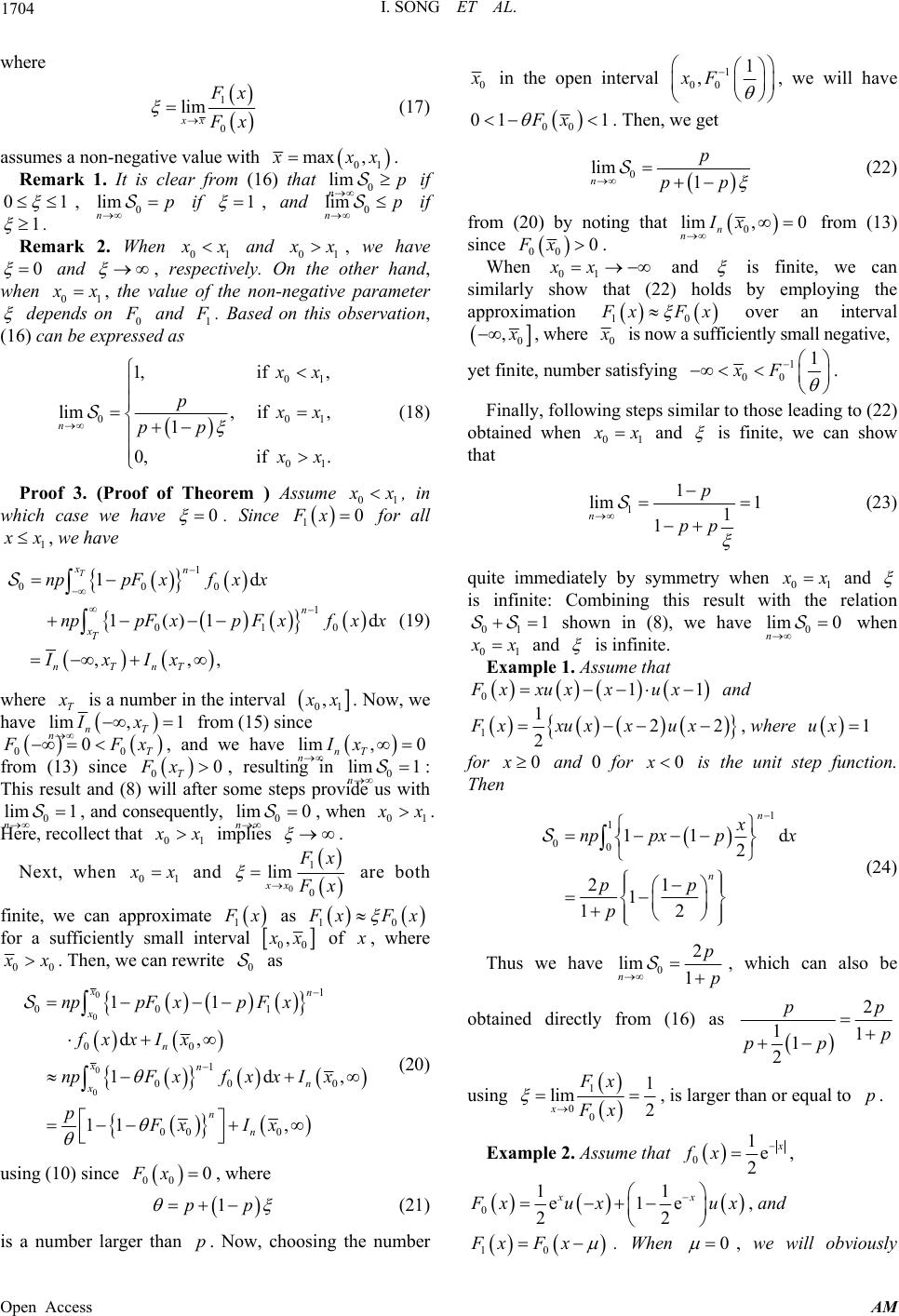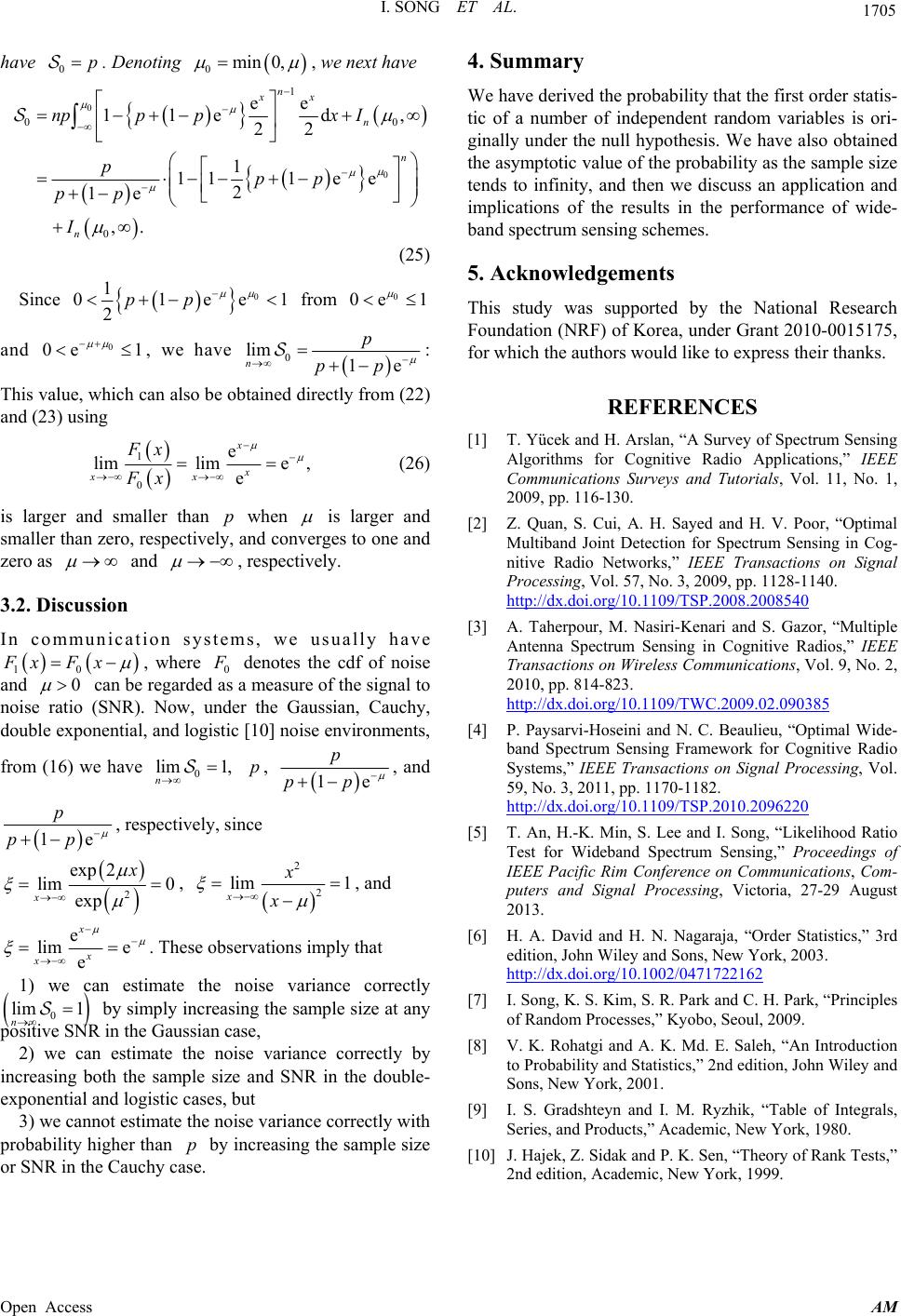 Applied Mathematics, 2013, 4, 1702-1705 Published Online December 2013 (http://www.scirp.org/journal/am) http://dx.doi.org/10.4236/am.2013.412231 Open Access AM Asymptotic Value of the Probability That the First Order Statistic Is from Null Hypothesis Iickho Song1, Seungwon Lee1, So Ryoung Park2, Seokho Yoon3* 1Department of Electrical Engineering, Korea Advanced Institute of Science and Technology, Daejeon, South Korea 2School of Information, Communications, and Electronics Engineering, The Catholic University of Korea, Bucheon, South Korea 3College of Information and Communication Engineering, Sungkyunkwan University, Suwon, South Korea Email: i.song@ieee.org, slee@Sejong.kaist.ac.kr, srpark@catholic.ac.kr, *syoon@skku.edu Received August 31, 2013; revised September 31, 2013; accepted October 8, 2013 Copyright © 2013 Iickho Song et al. This is an open access article distributed under the Creative Commons Attribution License, which permits unrestricted use, distribution, and reproduction in any medium, provided the original work is properly cited. ABSTRACT When every element of a random vector 12 ,,, n XX X assumes the cumulative distribution function 0 and 1 with probability and pp 1, respectively, we have shown that the probability that the first order statistic of 0 is originally under 0 can be expressed as . We have also shown that 010 11 dnppFx pFxFx 1n 0 0 lim 1 n p pp , where 1 0 lim xx x x and 01 max , xx with , i x the support of i x. Appli- cations and implications of the results are discussed in the performance of wideband spectrum sensing schemes. Keywords: Energy; Order Statistic; Probability; Spectrum Sensing 1. Introduction In wideband spectrum sensing (WSS) of wireless com- munications with a multiple of receive antennas, the pri- mary goal is to find vacant subbands in a wideband channel composed of a multitude of frequency bands [1-4]. It is beneficial in the WSS to have an accurate es- timate of the noise variance. For example, in the detec- tion scheme proposed in [5], estimation of the noise variance in a subband is performed based on the observa- tions in all the subbands. The accuracy of the estimate of the noise variance can be shown to depend on the distri- butions of the observatio ns under the null and alternative hypotheses. The key parameter in the estimation is the probability that the subband with the lowest energy is under the null hypothesis. In this paper, we focus on the asymptotic value of the probability and discuss its implications in the perform- ance of WSS schemes. 2. The Probability Let i be an absolutely continuous cumulative dis- tribution function (cdf) fo r and be a number in the open interval 0,1ip 0,1 . Consider a vector 12 ,,, n XX X of independent random variables, each of which assumes the cdf 0 and 1 with probability and 1F pp , respectively: On the average, random variables of the sample np has population cdf 0 and the rest has as the population cdf. Denote by 1 F 1 i Pr i F the probability that the first order statistic 1 of is one of the random variables [6,7] having the cdf i by for and 1. 0 x 1n i 1 1 f Fx Lemma 1. The probability can be expressed as i 11p F Fx x 10 p x n p 00 pF 11 0 x 1 f d 1 d, np np (1) and 1xx (2) where i d d i xFx x denotes the probability density function (pdf) corresponding to the cdf i for 0,1i . Proof 1. By let us denote the event that the cdf of k E *Corresponding author.  I. SONG ET AL. 1703 k random variables among the random variables of n is 0 and that of the rest random variables is 1 nk . Then, since 12 ,,, n XX 1pp X is an independent random vector, we easily get [8] Pr . nk k knk EC 0 (3) We can assume that j F for and 1j 1, 2,,jk F for under without loss of generality. Then we easily get 1,jk 2,k,nk E 00 11 1 110 1 PrPr , Pr ,. k kjj j k k FEXX XFE kXXXFE (4) Denoting the pdf of i and the joint pdf of under by k E k i Xi and Xk xE , respectively, xE we have 01 11 kn Xk i iik i xEfxf x , where 12 ,,, n xx x. Therefore, 2131 1 11 12131 1 1 0111 010 11 ,,, , dd d11d. n knk kn knk iinn xxxxxx iik XXXFEXXXX XXE 0 rPr P xfxxxxFx Fxfxx (5) Thus, from (4) and (5) , we ha ve 1 0010 Pr11d . knk k FEkF xFxfxx 1 (6) Finally, recollecting that 1 1 0 1 nn k n x k x nk kC [7,9] and combining (3 ) and (6), we get (1) as kk 1 000 10 1 00 1 010 Pr11 1d 11 d. nn knk nk kk n Pr FEpkCpF xpFxfxx nppF xxfxx 1 E F x p 0 01 11x f (7) Following similar steps, we can show (2). It is straightforward to see that 1 01 1 1d n npF pFx pf xpx n x x dtp (8) irrespective of the values of and , by letting , and therefore, . p 01 11p Fxt 01 1fxpf pF dx Next, we have 1x 001 1pFxp FpFx 01 p (9) since , , and 10 0 i Fx 01 ,Fx 01 1mFxaxx1pFx p F. Thus, noting that ,1 11 b a nn 00 n1 00 d , n a bnppFxxx pF ab f p F (10) we get 0 0, n I or 0 011 n p 0 (11) from (1) and (9) since and . 0 F 01F 3. Asymptotic Value and Its Implications 3.1. Asymptotic Value of 0 Let us now obtain the value more specifically. 0 lim n Lemma 2. Define 1 010 ,1 1 bn nad, abnppFxpFxfxx (12) where ab . Then, we have 00 0 lim,0 ifor0. n nIabFa FbFa (13) Proof 2. Recollecting that the pdf 0 x is non- negative and (9) holds at any point , it is clear that 0, ,. nn abI ab (14) Now, since 00 0 00 0, ifor0, lim ,1, if0 n n Fa FbFa Iab Fa Fb (15) from (10), we immediately have (13) from (14). Theorem 1. For 0,1i , let the support of the cdf i x be , i x . Then, we have 0 lim , 1 n p pp (16) Open Access AM  I. SONG ET AL. 1704 where 1 0 lim xx x x (17) assumes a non-negative value with 01 max , xx. Remark 1. It is clear from (16) that if 0 lim np 01 , if 0 lim np 1 , and 0 lim np if 1 . Remark 2. When 01 x and 01 x, we have 0 and , respectively. On the other hand, when 01 x, the value of the non-negative parameter depends on 0 and 1 . Based on this observation, (16) can be expresse d as 01 0 01 1,if , lim, if, 1 0,if . n0 1 x p x pp x (18) Proof 3. (Proof of Theorem ) Assume 10 x , in which case we have 0 . Since for all 1 Fx 0 1 x, we have 1 000 1 010 1d 1()1 ,,, T xn n xT nTnT nppF xfxx nppFxp Fxfxx IxIx d (19) where T is a number in the interval 01 , x. Now, we have lim n 0 , 1 nT Ix from (15) since 0 0T Fx , and we have n , 0 nT lim Ix m1 from (13) since , resulting in 0 n 0 T 0 Fx li 01 : This result and (8) will after some steps provide us with 0 n , and consequently, 0 n , when lim 1lim 0 x. Here, recollect that 01 x implies . Next, when 01 x and 0 1 0 lim xx x x are both finite, we can approximate 1 x as 10 xFx for a sufficiently small interval 00 , x of , where 00 x. Then, we can rewrite as 0 0 0 0 0 1 001 00 1 000 00 0 11 d, 1d 11 , xn x n xn n x n n nppFxp Fx fxxIx npFxfxxIx pFx Ix , (20) using (10) since , where 00 0Fx 1pp (21) is a number larger than . Now, choosing the number p 0 in the open interval 1 00 1 ,xF , we will have 00 01 1Fx . Then, we get 0 lim 1 n p pp (22) from (20) by noting that 0 lim, 0 n nIx from (13) since 00 0Fx. When 01 xx and is finite, we can similarly show that (22) holds by employing the approximation 10 xF x over an interval 0 , , where 0 is now a sufficiently small negative, yet finite, number satisfying 1 00 1 xF . Finally, following steps similar to those leadin g to (22) obtained when 01 x and is finite, we can show that 11 lim 1 1 1 n p pp (23) quite immediately by symmetry when 01 x and is infinite: Combining this result with the relation 01 1 shown in (8), we have 0 m 0 li n when 01 x and is infinite. Example 1. Assume that 01Fx xuxxux1 and 1122 2 Fxxux xux , where 1ux for and 0 for 0x0x is the unit step function. Then 1 1 0011 2 21 1 12 n n x nppx px pp p d (24) Thus we have 02 lim 1 n p p , which can also be obtained directly from (16) as 2 11 1 2 pp p pp using 1 00 1 lim 2 x Fx Fx , is larger than or equal to . p Example 2. Assume that 01e 2 fx , 011 e1e 22 xx xux u x , and 10 Fx Fx . When 0 , we will obviously Open Access AM  I. SONG ET AL. Open Access AM 1705 have . Denoting 0p 0min 0, , we next have 4. Summary 0 0n np p I 0 1 0 0 ee 11ed , 22 1 111e e 2 1e ,. n xx n n ppx I pp pp We have derived the probability that the first order statis- tic of a number of independent random variables is ori- ginally under the null h ypothesis. We have also obtained the asymptotic value of the prob ability as the sample size tends to infinity, and then we discuss an application and implications of the results in the performance of wide- band spectrum sensing schemes. (25) 5. Acknowledgements Since 0 1 01ee 2pp 1 from 0 0e 1 and , we have 01 This study was supported by the National Research Foundation (NRF) of Korea, under Grant 2010-0015175, for which the authors would like to express their thanks. 0 lim 1e p pp 0e n : This value, which can also be obtained directly fro m (22) and (23) using REFERENCES [1] T. Yücek and H. Arslan, “A Survey of Spectrum Sensing Algorithms for Cognitive Radio Applications,” IEEE Communications Surveys and Tutorials, Vol. 11, No. 1, 2009, pp. 116-130. 1 0 e limlime, e x x xx Fx Fx (26) is larger and smaller than when p is larger and smaller than zero, respectively, and converges to one and zero as [2] Z. Quan, S. Cui, A. H. Sayed and H. V. Poor, “Optimal Multiband Joint Detection for Spectrum Sensing in Cog- nitive Radio Networks,” IEEE Transactions on Signal Processing, Vol. 57, No. 3, 2009, pp. 1128-1140. http://dx.doi.org/10.1109/TSP.2008.2008540 and , respectively. 3.2. Discussion [3] A. Taherpour, M. Nasiri-Kenari and S. Gazor, “Multiple Antenna Spectrum Sensing in Cognitive Radios,” IEEE Transactions on Wireless Communications, Vol. 9, No. 2, 2010, pp. 814-823. http://dx.doi.org/10.1109/TWC.2009.02.090385 In communication systems, we usually have 10 Fx Fx , where 0 denotes the cdf of noise and 0 can be regarded as a measure of the signal to noise ratio (SNR). Now, under the Gaussian, Cauchy, double exponen tial, and logistic [10] noise env ironments, [4] P. Paysarvi-Hoseini and N. C. Beaulieu, “Optimal Wide- band Spectrum Sensing Framework for Cognitive Radio Systems,” IEEE Transactions on Signal Processing, Vol. 59, No. 3, 2011, pp. 1170-1182. http://dx.doi.org/10.1109/TSP.2010.2096220 from (16) we have , 0 lim 1, n p 1e p pp , and 1e p pp , respectively, since 2 [5] T. An, H.-K. Min, S. Lee and I. Song, “Likelihood Ratio Test for Wideband Spectrum Sensing,” Proceedings of IEEE Pacific Rim Conference on Communications, Com- puters and Signal Processing, Victoria, 27-29 August 2013. exp lim exp 2 x x 0 , 2 2 li x m 1 x x , and e lim e e x x x . These observations imply that [6] H. A. David and H. N. Nagaraja, “Order Statistics,” 3rd edition, John Wiley and Sons, New York, 2003. http://dx.doi.org/10.1002/0471722162 1) we can estimate the noise variance correctly n by simply increasing the sample size at any positive SNR in the Gaussian case, 0 lim 1[7] I. Song, K. S. Kim, S. R. Park and C. H. Park, “Principles of Random Processes,” Kyobo, Seoul, 2009. [8] V. K. Rohatgi and A. K. Md. E. Saleh, “An Introduction to Probability and Statistics,” 2nd edition, John Wiley and Sons, New York, 2001. 2) we can estimate the noise variance correctly by increasing both the sample size and SNR in the double- exponential and log istic cases, but [9] I. S. Gradshteyn and I. M. Ryzhik, “Table of Integrals, Series, and Products,” Academic, New York, 1980. 3) we cannot estimate the noise variance correctly with probability high er than by increasing the sample size or SNR in the Cauchy case. p[10] J. Hajek, Z. Sidak and P. K. Sen, “Theory of Rank Tests,” 2nd edition, Academic, New York, 1999.
|